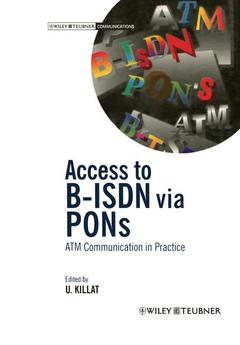Description
Access to B-ISDN via PONs, Softcover reprint of the original 1st ed. 1996
ATM Communication in Practice
Author: Killat Ulrich
Language: English
Subject for Access to B-ISDN via PONs:
Publication date: 12-2011
308 p. · 17x24.4 cm · Paperback
308 p. · 17x24.4 cm · Paperback
Description
/li>Contents
/li>Biography
/li>
It is with great pleasure that I respond to the kind invitation of the BAF project to contribute prefatory remarks to this account of their work, carried out under the auspices of the RACE Programme (Research and Development in Advanced Communications in Europe). The objective of the RACE Programme was to support the intro duction of Integrated Broadband Communications in the European Union. An important part of this overall objective was served by the BAF project, which has aimed to produce a cost-effective access facility for broadband networks, especially for residential and small business customers. As this book relates, in order to do so the project consortium merged two advanced communications technologies, ATM and PON, with contributions from many other disciplines, to create a demon strator which has been subject to extensive trials and testing which have been fruitful both in contributions to international standards and in development work to improve further future generations of the system. This book forms an important reference source through the experience gained in this unique experiment in advanced telecommunications. Another significant feature of the project should not be overlooked however. When the European Commission first began looking at supporting industrial research in Europe in the mid-1980s, it was clear that we had important strengths in telecommunications. It was equally clear that a revolution was on the way - the digital revolution - and European pre-eminence in the field was not guaranteed for ever.
Section 1 The ATM Technology.- 1.1 Introduction to ATM-based B-ISDN.- 1.2 The physical layer.- 1.3 The ATM layer.- 1.4 ATM adaptation layer (AAL).- 1.5 Connection admission control in ATM networks.- 1.6 Usage parameter control.- 1.7 Introduction scenarios.- Section 2 Passive Optical Tree Networks.- 2.1 Introduction.- 2.2 Technology.- 2.3 Multiple access methods.- 2.4 Multiplexing for bidirectional communication.- 2.5 PONs in support of ISDN.- Section 3 Access to B-ISDN via PONs.- 3.1 Introduction: network and service evolution.- 3.2 System architecture of the BAF system.- 3.3 The upstream synchronisation problem.- 3.4 Burst mode communication.- 3.5 The ranging problem.- 3.6 MAC protocols for passive optical networks.- 3.7 Performance Evaluation of MAC Protocols.- 3.8 Privacy and Authenticity in PONs.- 3.9 Interaction of a PON system with a B-ISDN local exchange.- 3.10 MANAGEMENT OF AN ATM PON.- 3.11 Field trials embedding the BAF system.
Prof. Ulrich Killat, Hamburg-Harburg
© 2024 LAVOISIER S.A.S.
These books may interest you

ISDN Technology 105.49 €



